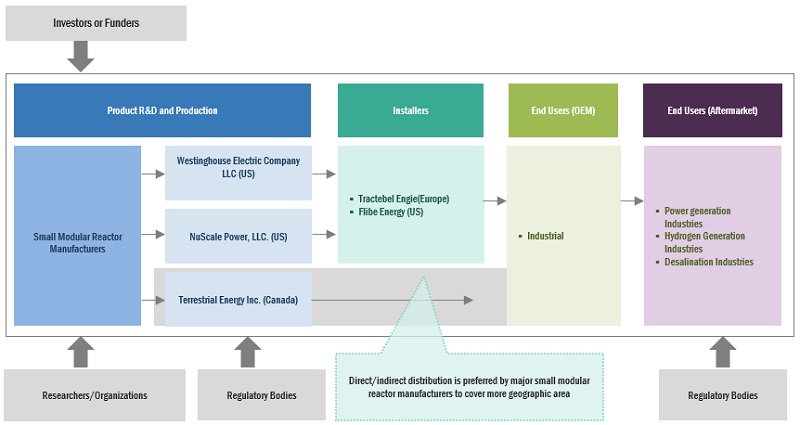New Revenue Pockets:
The global small modular reactor market size is estimated to be USD 5.8 billion in 2023 and is projected to reach USD 6.8 billion by 2030, at a CAGR of 2.3% during the forecast period. Factors such as the versatile nature of nuclear power and the relative advantages of SMRs such as modularization and factory construction are enabling the growth of the market.
“Small modular reactors (SMRS) are defined as nuclear reactors generally 300 MWe equivalent or less, designed with modular technology using module factory fabrication, pursuing economies of series production and short construction times,” according to the World Nuclear Association. The ability of SMRS to meet the requirements of flexible power generation for a wide range of applications, such as power generation, process heating, desalination, hydrogen production, industrial applications, and replacing ageing fossil fuel fired power plants, has increased demand for them.
Download PDF Brochure: https://www.marketsandmarkets.com/pdfdownloadNew.asp?id=5001546
In 2022, the Asia Pacific dominated the global small modular reactor market, followed by Europe and Americas. The region, by country, has been segmented into the China, Japan, India, South Korea, and the Rest of Asia Pacific. Due to the enormous number of SMR projects in China, Asia Pacific is a big contributor to the small modular reactor industry in the current environment. SMRs have the potential to replace coal- and other fossil-fuel-fired power stations in the region for power production and process heat applications, which will likely promote the expansion of the regional small modular reactor market.

The upto 100 MW segment by power rating is expected to be the third-largest growing segment of the small modular reactor market. The reactor unit can be built in a factory and delivered to the site of installation. Because of the modular construction, many SMR units can be deployed together to satisfy varied energy demands. A 100 MW SMR’s major use is electricity generating. It may function as a stand-alone power plant, supplying clean and dependable electricity to cities, industries, and isolated regions. The excess heat generated by a 100 MW SMR can be used for district heating, which involves distributing thermal energy to surrounding residential, commercial, and institutional buildings for space heating and water heating.
Speak to Analyst @ https://www.marketsandmarkets.com/speaktoanalystNew.asp?id=5001546
The gases segment by coolant is projected to be the fastest growing segment of the small modular reactor market. During operation, the gas-cooled reactor uses helium as a coolant medium, allowing it to be easily pressurized and maintain a stable high temperature, allowing for greater operational efficiency. Using gas as a medium in the reactor can prevent corrosion on the reactor’s surfaces, reducing the need for maintenance. These operational advantages are propelling the gases segment forward. Graphite is used as a neutron moderator in gas-cooled reactors, and carbon dioxide gas is used as a coolant.
The light-water reactors segment by type is projected to be the fastest growing segment of the small modular reactor market. In 2022, the light water reactor category accounted for 40.6% of the small modular reactor market. These reactors, which use common water as a coolant, are the most widely used since they pose the fewest technological dangers. SMR designs based on LWR technology are similar to large-scale LWRs in use today. Such SMRS employ well-tested technologies and products with small and integrated components and higher passive safety measures over current big scale LWRS. Light-water SMRS have a better level of technological readiness than other SMB designs. Because traditional LWR technology is well-developed, these reactors provide fewer hurdles to present licencing processes. Most regulators are familiar with the technology, resulting in a relatively short learning curve for both regulatory bodies and designers in light water reactors. In the case of a Pressurised Water Reactor (PWR), this is done after the safety rods have been lowered and unlatched.
The hydrogen generation segment by application is projected to be the forth-largest growing segment of the small modular reactor market. Hydrogen is essential in a variety of industrial applications. It can help with the decarbonization of electricity and transportation by being used for energy storage or as a fuel for hydrogen fuel-cell cars, trains, ships, and aeroplanes. Hydrogen can be produced using the fast neutron reactor, molten salt reactor, and high-temperature reactor technologies. The type of reactor technology influences the choice of hydrogen technologies to be combined with the SMRS. Only electricity is required for a few hydrogen manufacturing systems, such as traditional electrolysis. In contrast, methods such as thermochemical cycles may just require process heat, whereas hybrid technologies, such as high-temperature steam electrolysis (HTSE) and hybrid thermochemical cycles, require both heat and electricity.
Request Sample Pages: https://www.marketsandmarkets.com/requestsampleNew.asp?id=5001546
Europe is expected to grow at the second-highest CAGR during the forecast period. Russia, the United Kingdom, France, and the rest of Europe are all considered in the European small modular reactor market. Italy, Luxembourg, Denmark, the Czech Republic, Sweden, Ukraine, Finland, Estonia, Poland, and Romania are included in the rest of Europe. Nuclear energy accounts for around 28.4% of the region’s electricity generation mix, according to the BP Statistical Review of World Energy 2022. The region was responsible for 30.2% of global nuclear power usage. Investments in SMRS development, as well as a trend towards the usage of clean energy to address climate change, are expanding the potential for SMRS deployment in this region. For instance, the government dedicated USD 298 million to SMRS in 2021 as part of the UK Research and Innovation (UKRI) Low-Cost Nuclear (LCN) programme in November 2020. UKRI offered an initial match financing of USD 23 million to the UK SMR consortium lead by Rolls-Royce in November 2019 for the development of a conceptual SMR design. Rosatom (Russia) announced intentions to invest USD 7 billion in new nuclear technology by 2030 in June 2021.


